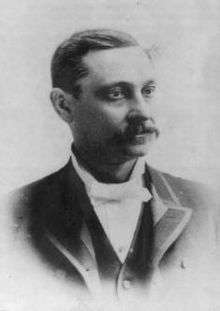Timothy J. Campbell

Timothy John Campbell (January 8, 1840 – April 7, 1904) was an American lawyer and politician from New York.
Life
Born in County Cavan, Ireland, he emigrated to New York City.
He was a member of the New York State Assembly (New York Co., 6th D.) in 1868, 1869, 1870, 1871, 1872, 1873, 1875 and 1883.
He was a member of the New York State Senate (6th D.) in 1884 and 1885.
He was elected as a Democrat to the 49th United States Congress, to fill the vacancy caused by the resignation of Samuel S. Cox, was re-elected to the 50th, and was elected again to the 52nd and 53rd United States Congresses, holding office from November 3, 1885, to March 3, 1889; and from March 4, 1891, to March 3, 1895.
Campbell earned a touch of immortality of an attributed nature. He is reported to have said to President Grover Cleveland, upon Cleveland's saying he would not support a bill on the grounds that the bill was unconstitutional, "What's the Constitution between friends?" (Bartlett's Familiar Quotations, 16th ed.)
References
- United States Congress. "Timothy J. Campbell (id: C000103)". Biographical Directory of the United States Congress.
| New York Assembly | ||
|---|---|---|
| Preceded by John Siegerson |
New York State Assembly New York County, 6th District 1868–1873 |
Succeeded by Matthew Patten |
| Preceded by Matthew Patten |
New York State Assembly New York County, 6th District 1875 |
Succeeded by Matthew Patten |
| Preceded by Matthew Patten |
New York State Assembly New York County, 6th District 1883 |
Succeeded by Peter Henry Jobes |
| New York State Senate | ||
| Preceded by Thomas F. Grady |
New York State Senate 6th District 1884–1885 |
Succeeded by Edward F. Reilly |
| United States House of Representatives | ||
| Preceded by Samuel S. Cox |
Member of the U.S. House of Representatives from New York's 8th congressional district 1885–1889 |
Succeeded by John H. McCarthy |
| Preceded by John H. McCarthy |
Member of the U.S. House of Representatives from New York's 8th congressional district 1891–1893 |
Succeeded by Edward J. Dunphy |
| Preceded by Amos J. Cummings |
Member of the U.S. House of Representatives from New York's 9th congressional district 1893–1895 |
Succeeded by Henry C. Miner |